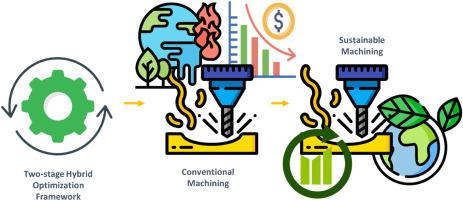Optimizing economic and environmental objectives in sustainable machining processes
IF 6.5
Q2 ENGINEERING, ENVIRONMENTAL
引用次数: 0
Abstract
This work presents a two-stage optimization approach designed to improve the sustainability of machining processes by integrating multi-objective optimization, multi-criteria decision-making, and experimental design approaches. The proposed work uses the non-dominated sorting genetic algorithm-II (NSGA-II) to balance economic and environmental objectives. A case study on the machining of EN8 steel demonstrated significant improvements after applying the proposed framework, achieving a 65.9 % increase in the environmental sustainability assessment (EnSA) and a 28.8 % improvement in the economic sustainability assessment (ESA). Key performance indicators, including total energy consumption of machine (TECM), temperature (T), and surface roughness (Ra), improved by 24.5 %, 25 %, and 48.8 %, respectively, though trade-offs between energy efficiency (EE) and process flexibility (PF). Sensitivity analysis highlighted that axial depth ('X4') was the most influential factor, accounting for 50 % of ESA variation and 86 % of EnSA variation. This framework offers a practical approach to optimizing machining parameters, contributing to sustainable manufacturing practices. Future research could extend its application to other manufacturing processes and incorporate additional sustainability dimensions, such as social impacts, to further promote overall sustainability in the industry.

在可持续加工过程中优化经济和环境目标
本工作提出了一种两阶段优化方法,旨在通过集成多目标优化、多准则决策和实验设计方法来提高加工过程的可持续性。提出的工作使用非支配排序遗传算法- ii (NSGA-II)来平衡经济和环境目标。对EN8钢加工的案例研究表明,应用该框架后,环境可持续性评估(EnSA)提高了65.9%,经济可持续性评估(ESA)提高了28.8%。关键性能指标,包括机器总能耗(TECM),温度(T)和表面粗糙度(Ra),分别提高了24.5%,25%和48.8%,尽管在能源效率(EE)和工艺灵活性(PF)之间进行了权衡。敏感性分析显示,轴向深度(X4)是影响最大的因素,分别占ESA变化的50%和EnSA变化的86%。该框架提供了一种实用的方法来优化加工参数,有助于可持续的制造实践。未来的研究可以将其应用扩展到其他制造过程,并纳入额外的可持续性维度,如社会影响,以进一步促进行业的整体可持续性。
本文章由计算机程序翻译,如有差异,请以英文原文为准。
求助全文
约1分钟内获得全文
求助全文
来源期刊

Cleaner Engineering and Technology
Engineering-Engineering (miscellaneous)
CiteScore
9.80
自引率
0.00%
发文量
218
审稿时长
21 weeks
 求助内容:
求助内容: 应助结果提醒方式:
应助结果提醒方式:


